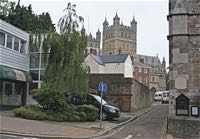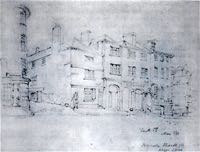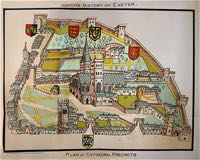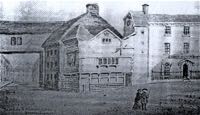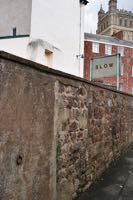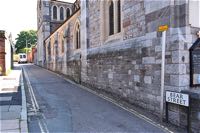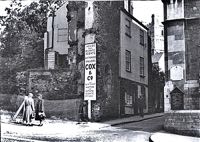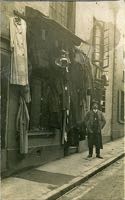
Bear Gate and Bear Tower
Page updated 2nd February 2016
 Bear Gate was situated at the opposite end of
Bear Street (sometimes referred to as Bear Lane), and was one of seven gates around the
Cathedral Close. The Close was gated in 1286, after the murder of Walter Lechlade, on
the 5 November 1283, so that it could be closed at night.
Bear Gate was situated at the opposite end of
Bear Street (sometimes referred to as Bear Lane), and was one of seven gates around the
Cathedral Close. The Close was gated in 1286, after the murder of Walter Lechlade, on
the 5 November 1283, so that it could be closed at night.
John Hoker that the the Bishop and Dean and Chapter agreed to erect the seven gates around Cathedral Yard, and this included a "broad gate, eight foot in width, between the House of the Dean of Exeter and the house which is now in possession of Master Roger of Dartford."
The Bear Gate had a simple pitched roof before a chamber was added over by 1584, as Mr Barcombe paid two pence per year in consideration of "his new building over the gate going into the churchyard by the said Bear Gate".
The chamber was leased to succession of tenants, some of whom were poor and in reciept of poor reliefe. In March 1625, Nicholas Strawe, was given permission to build stairs from Mr Chanter's house into the chamber over the gate "so as it be not prejudicial to Mr Chanter's lights". The existing access to the chamber from the Bear House was to be blocked.
Richard Dewdney leased the chamber over the gate and the Royal Oak messuage in St Georges for many years. He appears to have sublet the chamber over the gate for in 1696 poor relief was granted to Goody Day, a poor woman living in the Bear Gate. By 1718, Dewdney's son, Nathaniel Dewdney was granted a new lease. The lease of the chamber passed to his widow in 1753, until 1764 when it was relet in March 1764.
Demolition
In 1812, the Cathedral decided to remove the chamber over Bear Gate "leaving a Gateway of the same breadth and height as at present and to be shut as usual." The gates were also to be removed and temporary posts and chain installed to prevent passage through the gate "for the usual hours at night as often as the Chapter shall think fit...and at least on Midsummer Day in every year." By the next year, Robert Cornish surveyed the gates around the Close and concluded for Bear Gate should be totally removed and replaced with an iron gate.
It was demolished in the Spring of 1813 and Thomas Matthews paid the sum of £10 for taking down and repairing the sides. He was allowed to remove the salvaged material for his own use.
Sources: Cathedral Archives
│ Top of Page │
